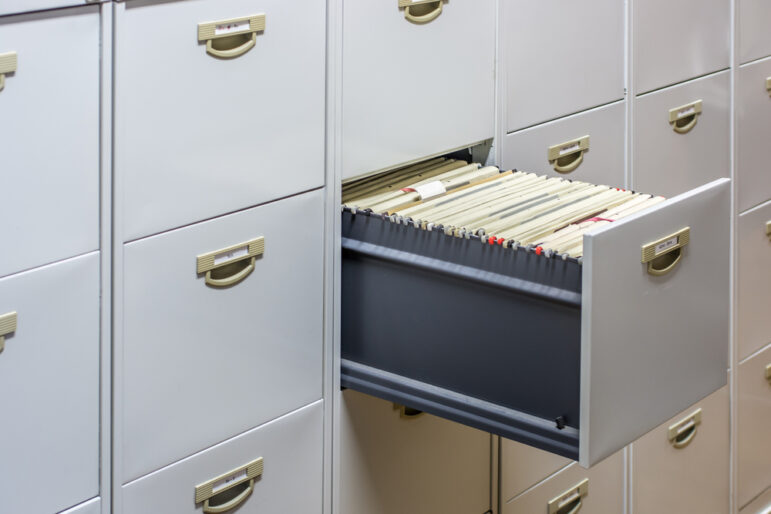

Indian Journalists Challenge Government Over Coronavirus Transparency

A viewer watches Indian Prime Minister Narendra Modi address the nation on television in April, amid the COVID-19 outbreak. Image: Sumit Saraswat / Shutterstock
Late in March, Indian journalist Supriya Sharma tweeted: “I’ve been following all press briefings by India’s health ministry and reading every press note on #COVID2019. The government is stonewalling questions, not giving basic information.”
That was when Sharma released a set of 10 questions compiled by a collective of health reporters and published it in Scroll, where she is executive editor. The collaborative effort sought official answers on overall health preparedness such as drug availability, access to care, the state of the country’s health inventory, and insurance schemes — questions the administration had been avoiding.
It was a public display of how Indian journalists have been calling out the government on social media over its opacity in the face of the COVID-19 pandemic. The health ministry’s website has been cluttered and unclear, reporters say. Press briefings — conducted by medium-ranking bureaucrats, with national political leaders and scientific experts largely missing from the scene — have been confusing at best, and misleading at worst. Journalists claim there have been attempts to brush important details under the carpet and limit access to data, even under the Right to Information Act.
But continued questions posed by Sharma and her colleagues have been helping frame the larger debate on COVID-19 in India, and will, in the future, serve as a record of government accountability, or the lack thereof.
“The questions raised public awareness, perhaps even added to the pressure on the government, even if they did not immediately elicit any answers,” said Sharma.
High Stakes
The risks are enormous. India is the world’s second most populous country, with 1.3 billion people. Its economic disparities, density of population, poor health infrastructure, and lack of access to sanitary conditions pose huge challenges to fending off a pandemic that has already claimed 257,000 deaths worldwide.
India had its first confirmed case of COVID-19 on January 30. Since then, the government repeatedly said it had taken stock of existing healthcare systems, but it remained tardy in disseminating essential information, such as the availability of intensive care beds, isolation wards, ventilators, test kits, and protective gear.
India has been under a stringent lockdown for weeks. But despite the aggressive measures, the virus is showing no sign of retreat. As of May 6, India had 49,400 cases and 1,693 deaths, according to the Johns Hopkins University Coronavirus Resource Center. On Sunday, the country reported a record jump, with 83 deaths and nearly 2500 new cases in one day. The lockdown, put in place March 24, has been extended until the middle of May.
Journalists say instead of offering up the realities on the ground, the government has tightened the lid on information — part of a longer trend of muzzling a free press. Last month, Reporters Sans Frontières (RSF) released its World Press Freedom Index. India dropped two points lower than the previous year to rank 142; since 2016, when India ranked 133, its ranking has been slipping consistently. RSF attributes this partly to Prime Minister Narendra Modi — who came to power in 2014 — tightening his grip on the media and pressuring media groups to “toe the Hindu nationalist government’s line.”
Reporting the Crisis
Starting mid-March, officials from the Ministry of Health and Family Welfare department held daily media briefings in Delhi. Initially, reporters attended the briefings in disbelief.
“Getting information out of this government is like pulling teeth,” veteran health journalist Vidya Krishnan told GIJN in April, adding that the opacity has only increased since the breakout of the pandemic.
“This kind of gaslighting has never happened before,” Krishnan said. “The government is jeopardizing the nation by not taking us into confidence.” She now puts out regular Twitter threads highlighting the government’s stranglehold on data and overall ill-preparedness, even while some of her reporting has made her the target of death threats.
Government spokesperson Kuldeep Singh Dhatwalia pushed back on the criticism about the government’s handling of the crisis, saying he hadn’t heard any complaints from journalists. “We are providing information on a day-to-day basis through press releases, conferences and briefings,” Dhatwalia said. “If there is a problem, journalists should tell us.”
Collaborative Reporting
GIJN spoke to several English-language media journalists for this story, most of whom said that in normal circumstances, one could get around the stonewalling.
“That’s our job as journalists; when you don’t get something through official channels, we go on the ground and get it from sources,” one health reporter said. “But during a pandemic when there are restrictions on movement, why basic information which should be in the public domain is not being communicated is just mind-boggling.”
Meanwhile, channels that had been open at the beginning of the crisis have now closed, including doctors who were speaking to journalists and have now been instructed not to.
For the televised press conferences currently underway, journalists are only allowed to ask questions via a government WhatsApp group. Of 20-odd questions, officials pick roughly three.
“They deflect questions, give half-baked responses, say they will get back on some questions but never do. They always avoid talking about preparedness,” said health reporter Swagata Yadavar. Recently, journalists said the government dodged questions on Chinese testing kits allegedly purchased by India at high cost. Kits from two companies were found to be faulty.
There have also been attempts to silence journalists at briefings. At a March briefing, India’s Press Information Bureau (PIB) only fielded questions by Doordarshan, the official state broadcaster, and Asian News International, a news agency known to toe the government line. After reporters took to social media to complain, officials were back to taking questions from other organizations. A week later, they decided only PIB-accredited journalists would be welcome to press conferences, even though accreditation is a lengthy process, currently only open to print and television media.
In April, the Health Ministry’s Lav Agarwal insisted at a press conference that only 0.2% of the tested samples were positive, when in fact the figure was 2%. On another occasion, he wrongly attributed figures to the Indian Council of Medical Research, later having to clarify that he was actually referring to a study carried out by a different organization. In both cases, by the time the clarification came, several thousand people had seen the conference and a number of media had reported the misinformation.
To make sense of the confusion, health and science reporters have been falling back on their collective expertise with regular discussions on social media to help fill knowledge gaps and, according to one of the journalists, to “cobble together information from the scraps we have.”
“If one of us has information that can’t be confirmed, another steps in to reach out to their source and so on,” the reporter said.
Some states, though, have been more forthcoming with information than others. Tamil Nadu, for instance, has been releasing the age groups and sex of patients; this helps in seeing trends. The states of Maharashtra and Kerala, too, have been transparent. Kerala has even flattened the curve and, of many reasons cited for this, clear communication has been one.
Controlled Coverage
Since the pandemic broke out in the country, Modi has made numerous televised addresses but has barely touched upon measures taken to tackle the health emergency. His lack of accountability during the pandemic is in line with his six years of tenure as prime minister, during which he has only held one press conference in which he refused to take questions.
A few hours before announcing the lockdown, Modi met with more than 20 editors and owners of mainstream print media from across the country. A report on Modi’s official website said that the media had “played a praise-worthy role in disseminating information” but that it was also important to tackle the spread of pessimism, negativity, and rumor mongering. The report added that the editors would “work on the suggestions of the Prime Minister to publish inspiring and positive stories.”
A recent investigation by the long-form narrative magazine Caravan showed that tactic might have worked. It found few media organizations critical of the government in their pandemic coverage. Caravan executive editor Vinod Jose said he didn’t think the problem in Indian journalism was lack of reporting skills.
“It is the lack of courage of editors to fight for the reporters and their stories,” he said. “And the pliability of media owners under commercial and political pressures.”
But some government initiatives have gone even further in efforts to delegitimize the press. An official PIB Fact Check Twitter handle was created in December and regularly flags critical coverage of the pandemic as fake. Meanwhile, in March, the central government asked the Supreme Court to direct the media to “ascertain the true factual position” of the government before publishing stories on COVID-19 — a move which it rejected.
Senior investigative journalist Thomas Abraham maintains that in Indian media, it is business as usual.
“The government is doing what it always has,” Abraham said. “You can’t expect a sudden burst of transparency because there’s a pandemic.”
 Sukhada Tatke is an independent journalist. She writes on gender, inequality, culture, and urban affairs, among other things. Her stories have been published by Al Jazeera, Wired, CityLab, PRI, Texas Monthly, and Atlas Obscura.
Sukhada Tatke is an independent journalist. She writes on gender, inequality, culture, and urban affairs, among other things. Her stories have been published by Al Jazeera, Wired, CityLab, PRI, Texas Monthly, and Atlas Obscura.









